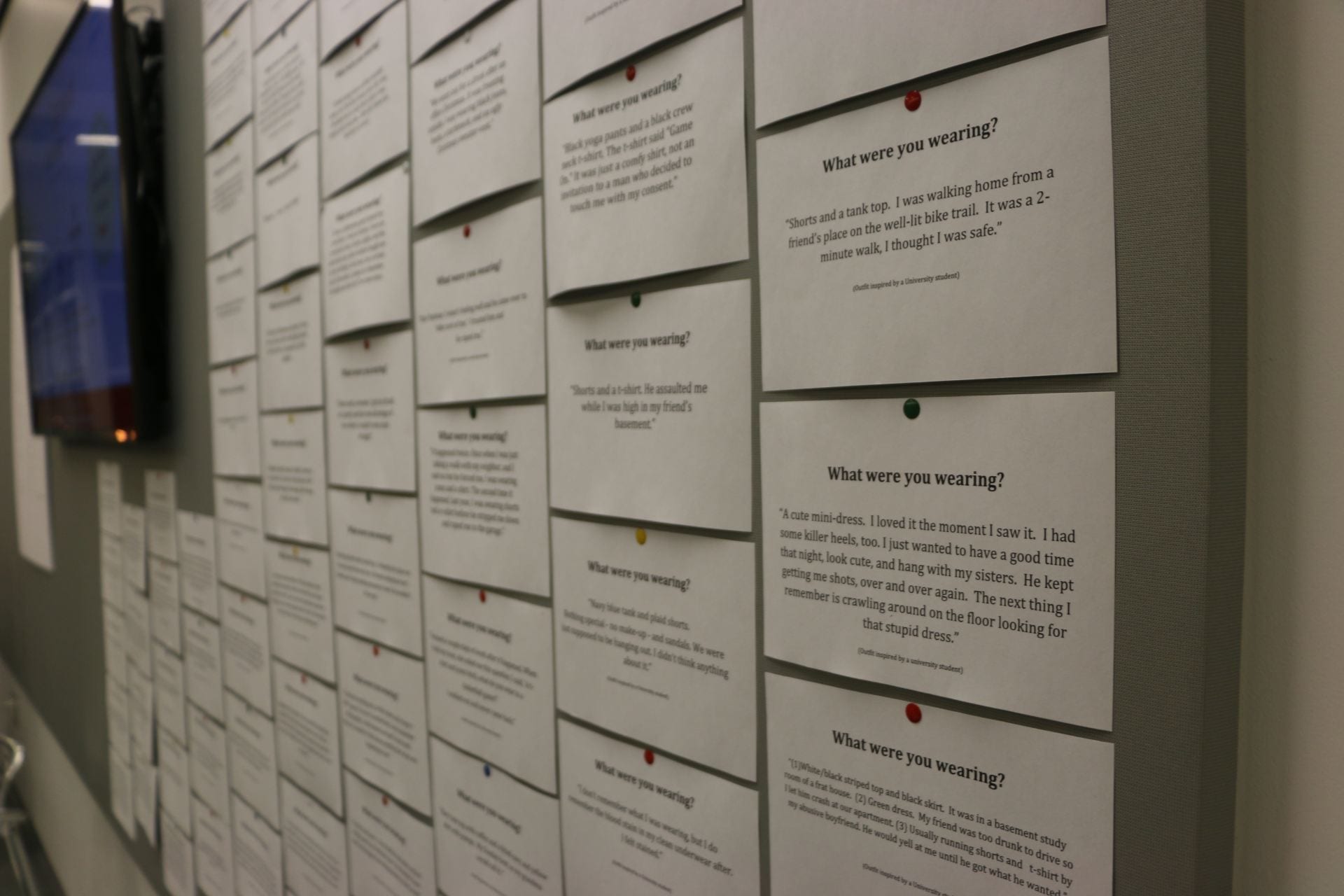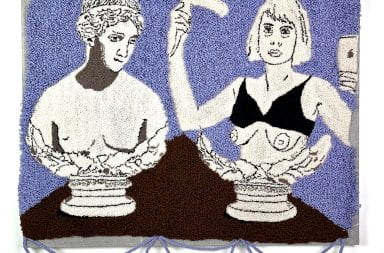
A wall of “What Were You Wearing?” responses at the Cunz Hall on Nov. 27. Credit: Katie Hamilton | Arts & Life Director
Suggesting that women should dress differently won’t prevent sexual assault, but that doesn’t stop people from questioning what victims were wearing when they were assaulted. Now, an Ohio State student is trying to take down this outdated notion.
“For the first time survivors are answering the question ‘What were you wearing?’ on their own terms,” Noa Katz, a fourth-year in public health, said. “It is not somebody asking them to relive the trauma and blaming them for it, it is being asked in an effort to show that their sexual assault wasn’t about their clothes.”
The “What Were You Wearing” art exhibit, created by Katz and on display in Cunz Hall this week for #MeToo week, showcases 20 different recreations of outfits worn by sexual assault survivors at the time of their assault in an effort to eliminate the myth that a victim is created based off what they choose to wear.
“The idea of, ‘What were you wearing?’ as an acceptable response to somebody after they’ve been assaulted has been one of the most pervasive rape myths in our culture,” Katz said. “I’m hoping people are able to look at these clothes and understand that ending sexual violence isn’t as simple as asking someone to change their outfit.”
Katz posted an anonymous survey in October on social media asking Ohio State sexual assault survivors what they were wearing. She said she only expected to get around 10 responses, but received 80 in less than a month.
The amount of responses the survey received surprised Katz, who believes it speaks to how many people are experiencing this issue that she believes is a real problem on campus that hasn’t been handled well. The 20 outfit descriptions she chose will be displayed along with the clothing.
“I think reading the words that people submitted and how differently so many people answered the same question is really important,” Katz said. “I think the answers can help us move away from victim-blaming and blaming people for where the assault happened or how it happened.”
One example from an Ohio State student at the exhibit said she was just trying to walk home.
“Shorts and a tank top. I was walking home from a friend’s place on the well-lit bike trail. It was a two-minute walk, I thought I was safe.”
Katz said picking the stories to display was the hardest part of creating the exhibit. She said she tried to select the outfits that would resonate most with students on a college campus, such as stories that mentioned dorms or Ohio State clothes.
When dealing with the stigma surrounding sexual assault of an intoxicated victim, Katz said she wanted to display stories that included intoxication even more to combat the idea that assault becomes the victim’s fault if they are intoxicated.
One such example at the exhibit read:”Shorts and a-shirt. He assaulted me while I was high in my friend’s basement.”
Katz said she isn’t the first to create an exhibit like this. The concept originated at Kansas University by Jennifer Brockman, whom Katz spoke with. She said she was excited by the idea of bringing this to Ohio State in the wake of the shutdown of the Sexual Civility and Empowerment unit.
Katz works as an advocate at the Sexaul Assault Response Network of Central Ohio, where she personally works with survivors by guiding them through the medical exam and reporting process. She said that the people she’s met while working there have made a huge impact on her and inspired her to recreate this exhibit at Ohio State.
In addition to being open all week at Cunz Hall, there will be a reception at 5 p.m. on Thursday, featuring student organization It’s On Us, which will be hosting a pledge drive.
SARNCO will provide confidential advocates who help viewers process their response to the program, as well as give additional resources if wanted, according to Jill Davis, SARNCO campus prevention coordinator.
Davis said the presence of the advocates allows people to speak freely and share their story in whichever way feels right for them without being concerned that anything they say will be reported to the university.
“We know this exhibit can invoke some strong emotions and some of those emotions can be of previous trauma or painful, so we want to make sure people feel like they have a place to share those emotional experiences and receive appropriate support,” she said.


